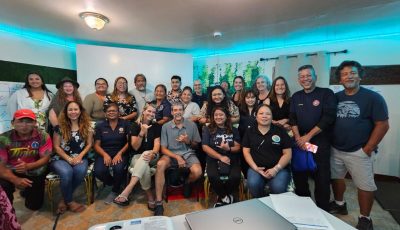IMMIGRATION LAWYERS TO EMPLOYERS:
‘Apply eligible CWs for H1 visas now’
Noted immigration lawyers Bruce Mailman from the CNMI and Nelson J. Xu from Guam have this important piece of advice to the islands’ employers: Start applying your eligible CW workers for H1 visas now.
Speaking before yesterday’s Society for Human Resource Management CNMI Chapter’s 2014 Annual Conference on the topic of “Current Immigration Issues for the CNMI,” Mailman and Xu agreed that the extension of the CNMI transition period—with yesterday’s signing of H.R. 83—should serve as a signal for Commonwealth employees to start evaluating their nonresident workforce and transition crucial employees to the U.S. immigration system.
“I think employers here should first of all take a look at the workforce and see who is eligible for U.S. visas. A lot of these people can also qualify for better level visas that they have. You have to change the job description, the job skills, and you have to qualify. H1 [visa] is for a specialty occupation, which means that a person has to qualify, usually a four-year degree, but there are certain exemptions and the job has to qualify,” said Mailman of Mailman & Kara, LLC.
Mailman, however, said while many current CWs are actually doing H1-level jobs in the CNMI, they would have to, in essence, give CWs a higher job designation in order to qualify for H1 visa.
“Maybe your accountant will have to become a comptroller and you have to demonstrate there is a real change. If you can do that, you have a good shot at it. If you can’t do that, it’s not gonna work. They’re very fussy about this.”
He also acknowledged that the CNMI’s lack of a prevailing wage survey is hindering more companies from applying for H1 visas.
“We need a prevailing wage survey. We’ve been using Guam’s and H1 petitions using the Guam scale is quite a bit higher.”
Mailman said a U.S. visa petition recently came through where an H1 applicant earning $45,000 a year was approved and because they needed to use Guam’s prevailing wage, this particular applicant must now be paid in the $70,000-a-year range.
“It’s something that each employer must decide if they can do it and if they can afford to do it. Hopefully we can get a wage survey and things will become more sensible,” he said.
Xu, a partner in Bauman, Kondas & Xu, one of Guam’s leading law firms in U.S. immigration and business law, echoed Mailman’s call for employers to start shifting CWs to H1 visas if they qualify.
“H1 has such tremendous benefit. First of all, these people are not in low-end jobs, they’re educated and they’re in specialty occupations like engineers, doctors, and all these people. Then they can stay here for six years. Renewal is three years at a time so you save a lot of money from it. And then they can switch to green card very easily and it becomes a permanent solution. Compare H1 to one-year only CW and clearly H1 is a much better alternative,” he said.
Xu said employers must get rid of the trauma and stigma associated with giving loyal, long-term, and valuable employees green cards.
“Many employers I’ve talked to, they’re reluctant to apply their employees for green cards because they worry that if their employers have it they will leave, which is likely to happen, unfortunately. But if you treat them right, give them a higher wage, benefits, and stuff like that and of course they might still stay. On the other hand, what are you going to do after five years? Everybody’s gone so you need to select who you want and actively select who you want to keep and start working on it.”
He, however, acknowledged that most of the CWs can’t qualify for H1 visas because they don’t have the qualification for H1 and that’s where family-based visas can help.
“This is a SHRM conference. [But] there’s family-based and you have to explore other options. If you have a CW worker who has a U.S. citizen child who is turning 21 years old in the next five years, then you may not want to do anything and just wait for the child to turn 21. That’s a nice way. Family-based, if they’re qualified, is very easy. Employment-based is difficult.”
Mailman agreed with Xu when he said, “many of our workers here have U.S. citizen children who will in the next few years will turn 21 years old. These children can sponsor their parents. That’s a source of stability.”
Xu also said that CNMI employers must not treat the enactment of H.R. 83 into law as the beginning of the end of the yearly rush of renewing CW applicants, but the start of preparations for the end of the transition period.
“This is not the end. This is the beginning. It’s time because five years is the end of the five-year transition. There will be no more extensions from what we know on what the law says. Everybody must think about how to transition to the U.S. immigration system and depart from the CNMI immigration system. Even though the CNMI immigration system is controlled by the U.S. system, we need to move into the U.S. system and apply for green card and apply for U.S. immigrant visas that make sense to them. That’s the take away. I don’t want to see any employer wait until 4 ½ years later and they all come to me and say ‘Nelson, we need help.’ I’ll tell them ‘this time we’re closed’ because next time we won’t be able to do anything.”
SHRM”s 2014 Annual Conference was held at the Pacific Islands Club Saipan’s Charley’s Cabaret and it was attended by over 100 human resources practitioners on the island. U.S. Citizenship and Immigration Services’ Diane Zedde also spoke during the event.



























